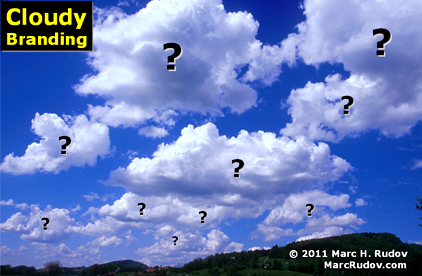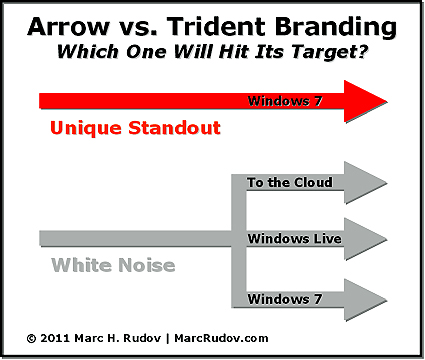By now, I’m sure you’ve seen Microsoft’s series of “to the cloud” commercials. These spots, as demonstrated in the clip below, make two fundamental branding errors: 1) selling “the cloud,” yet another generic, nebulous form of technobabble; 2) sending viewers three murky messages instead of a single crisp one.
The three messages in the clip above are: cloud, Windows Live, and Windows 7 — in that order. If we stop the clip after the actors send us to “to the cloud,” we have NO clue about the advertiser. We’re already confused and distracted, instead of confident and focused.
To the cloud. What does that mean? Which cloud? Where can we buy the cloud? Is there a cloud store? We have no idea. The cloud is just a puffy mass of white noise to us.
Branding Error #1
Yet, Microsoft’s initial salvo is the generic cloud message, and we don’t know Microsoft is behind it. Branding error #1. Worse, almost every other tech vendor also speaks “cloud” lingo — except Apple (read Cloud Computing: Branding Fog).
Without a unique, gut-grabbing, memorable, repeatable brand (value proposition), a vendor has no hook and gets no traction. Spouting generic technobabble is tantamount to wasting the shareholders’ money — and the customers’ time.
Is Microsoft showing us a problem scenario in this spot to which we, as business professionals, can relate? Sure. We want to connect with geographically dispersed colleagues. No argument there.
Microsoft’s solution? We don’t know. There’s this “cloud,” whatever that is. Then, there’s Windows Live, followed by Windows 7. So, what’s your message, Microsoft? And, how do your three messages interrelate? Hint, Microsoft: it’s not our job to decipher your brand.
Rudov’s Rule of Branding: a vendor’s customers must react to, remember, and repeat its value proposition — its brand — or the branding effort has failed.
Branding Error #2
We neither have a gut reaction to nor remember Microsoft’s three messages, as humans can’t process three messages. Consequently, we cannot repeat the messages to our colleagues, because we have no idea what to repeat! Branding error #2.
Have you ever seen an archer use a trident? Of course not. Such an act would be both aerodynamically and ballistically futile. Only sharp, single-tipped arrows will fly, hit their targets, and stick to their targets. This is axiomatic in branding, too.
Yet, in communicating their brands — via homepages, speeches, ads, media appearances, and sales pitches — most companies use tridents instead of sharp, single-tipped arrows, believing that fatter ordnance yields better impact. They’re wrong.
Rx from The WhiteNoise Doctor™
Had Microsoft simply stated its legitimate case — barriers to collegial connectivity raise the cost of sales — and then offered Windows 7 as the solution, we would view Microsoft as the unique standout for simply articulating our problem and offering us a clear, easy solution.
Instead, Microsoft sent us to the murky, generic cloud — the same ambiguous buzzword its competitors use. Why, then, should we buy from Microsoft? We want a unique-standout vendor, not one stuck in the white noise with its me-too competitors.
Microsoft’s singular goal is to get us to want and buy Windows 7, period. Alas, Microsoft blew it by clouding its brand in the cloud.
We don’t care, or want to know, how Microsoft connects us to our colleagues, because the technology will change again in six months. We care only that Microsoft can do it and explain it, simply — like hitting a bullseye in one shot.
POSTSCRIPT #1
Microsoft Gets It Right: December 2011
POSTSCRIPT #2: Microsoft Kills WindowsLive
© 2011 Marc H. Rudov. All Rights Reserved.
About the Author

Marc Rudov is a branding advisor to CEOs,
producer of MarcRudovTV, and author of four books



